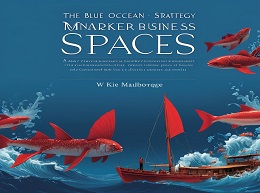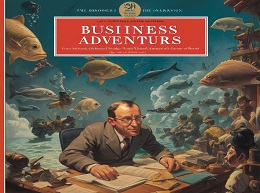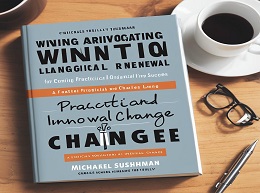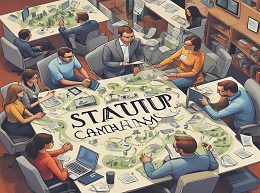The Blue Ocean Strategy: How to Create Uncontested Market Space and Make the Competition Irrelevant

"The Blue Ocean Strategy: How to Create Uncontested Market Space and Make the Competition Irrelevant" - A Detailed Review
In today’s hyper-competitive business landscape, finding a way to stand out is more crucial than ever. "The Blue Ocean Strategy: How to Create Uncontested Market Space and Make the Competition Irrelevant" by W. Chan Kim and Renée Mauborgne provides a revolutionary approach to achieving this. By encouraging businesses to move away from saturated markets (red oceans) and instead create new, uncontested market spaces (blue oceans), the book offers a strategic framework for innovation and growth. This review delves into the core concepts, practical tools, and illustrative examples presented in the book, offering a comprehensive understanding of how to apply these principles to foster business success.
The Core Premise: Red Oceans vs. Blue Oceans
The book begins by contrasting two types of market spaces: red oceans and blue oceans. Red oceans represent all the industries in existence today the known market space. In red oceans, industry boundaries are defined, and companies try to outperform their rivals to grab a bigger share of the market. As the space gets crowded, prospects for profits and growth diminish.
Blue oceans, on the other hand, denote all the industries not in existence today the unknown market space. In blue oceans, demand is created rather than fought over, and there is ample opportunity for growth that is both profitable and rapid.
Formulating a Blue Ocean Strategy
The authors outline a systematic approach to creating blue oceans, which involves reconstructing market boundaries, focusing on the big picture, reaching beyond existing demand, and getting the strategic sequence right.
Reconstructing Market Boundaries
To break out of red oceans, businesses need to look across the conventional boundaries of competition. The book presents six paths for reconstructing market boundaries:
1. Look across alternative industries.
2. Look across strategic groups within industries.
3. Look across the chain of buyers.
4. Look across complementary product and service offerings.
5. Look across the functional-emotional orientation of an industry.
6. Look across time.
Example: Cirque du Soleil is a prime example of this approach. By combining elements of the circus with theater, Cirque du Soleil created a new market space that appealed to a broader audience and commanded higher prices.
Focusing on the Big Picture, Not the Numbers
Strategic planning should be driven by a vision that transcends traditional metrics. The authors introduce the concept of the strategy canvas, a diagnostic and action framework for building a compelling blue ocean strategy. It captures the current state of play in the known market space and helps identify factors that should be eliminated, reduced, raised, or created to unlock a new value curve.
Example: Southwest Airlines used the strategy canvas to focus on factors such as speed, convenience, and low cost while eliminating factors like meal services and reserved seating, creating a new market space in the airline industry.
Reaching Beyond Existing Demand
To maximize the size of their blue oceans, companies need to unlock new demand. This involves looking at noncustomers and understanding why they refuse the current offerings in the market.
Tiers of Noncustomers
The book identifies three tiers of noncustomers that can be tapped into:
1. The First Tier: “Soon-to-be” noncustomers who are on the edge of your market.
2. The Second Tier: “Refusing” noncustomers who consciously choose against your market.
3. The Third Tier: “Unexplored” noncustomers who are in markets distant from yours.
Example: The Nintendo Wii targeted casual gamers and non-gamers by offering a more intuitive and physically engaging gaming experience, thus tapping into a vast new customer base beyond traditional hardcore gamers.
Getting the Strategic Sequence Right
A blue ocean strategy must align with the sequence of buyer utility, price, cost, and adoption. The authors stress the importance of creating a compelling utility proposition, setting a strategic price, building a viable business model, and overcoming adoption hurdles.
The Buyer Utility Map
The buyer utility map helps identify where your product or service can unlock exceptional utility for the customer. It considers six stages of the buyer experience cycle: purchase, delivery, use, supplements, maintenance, and disposal.
Example: iTunes revolutionized the music industry by simplifying the purchase and use stages of music consumption, offering easy access and a vast library of songs for users.
Practical Tools for Implementing Blue Ocean Strategy
The book provides several practical tools and frameworks to help businesses implement blue ocean strategies effectively.
The Four Actions Framework
This framework helps reconstruct buyer value elements in crafting a new value curve. It involves asking four key questions to challenge an industry’s strategic logic and business model:
1. Which factors should be eliminated?
2. Which factors should be reduced well below the industry’s standard?
3. Which factors should be raised well above the industry’s standard?
4. Which factors should be created that the industry has never offered?
Example: In the wine industry, Yellow Tail applied the Four Actions Framework to simplify wine selection and appeal to non-wine drinkers. They eliminated the complexity of wine terminology, reduced the range of wines offered, raised the focus on taste and packaging, and created an easy-drinking wine that was fun and accessible.
The Strategy Canvas
As mentioned earlier, the strategy canvas is a central diagnostic tool and an action framework for building a compelling blue ocean strategy. It visually captures the current state of play in the known market space and helps companies see how they can stand out.
Example: NetJets, a fractional jet ownership company, used the strategy canvas to identify key factors valued by customers (such as convenience and time-saving) and created a new market space by offering fractional jet ownership, which was more accessible than full jet ownership.
Real-World Applications of Blue Ocean Strategy
To illustrate the practical application of blue ocean strategy, the book includes numerous case studies from various industries.
Case Study: Cirque du Soleil
Cirque du Soleil is one of the most frequently cited examples of blue ocean strategy. By blending circus arts with theater and eliminating costly elements like star performers and animals, Cirque du Soleil created a unique entertainment experience that drew a new audience, transcending traditional circus and theater boundaries.
Case Study: [yellow tail] Wine
Yellow Tail, an Australian wine brand, successfully created a blue ocean by demystifying wine for the average consumer. They simplified the product line, focused on taste rather than complexity, and targeted beer and cocktail drinkers who found traditional wines intimidating.
The Impact of Blue Ocean Strategy
"The Blue Ocean Strategy: How to Create Uncontested Market Space and Make the Competition Irrelevant" offers a transformative approach to business strategy. By shifting focus from competing in existing markets to creating new market spaces, businesses can achieve sustainable growth and profitability.
The book provides a comprehensive framework with practical tools and real-world examples that illustrate how companies can systematically pursue blue oceans. Whether you are a startup seeking to disrupt an industry or an established business looking to reinvigorate growth, "The Blue Ocean Strategy" offers valuable insights and actionable strategies to help you navigate and create your own blue ocean.
By applying the principles of blue ocean strategy, you can break free from the constraints of competitive markets, unlock new demand, and propel your business to unprecedented heights.













